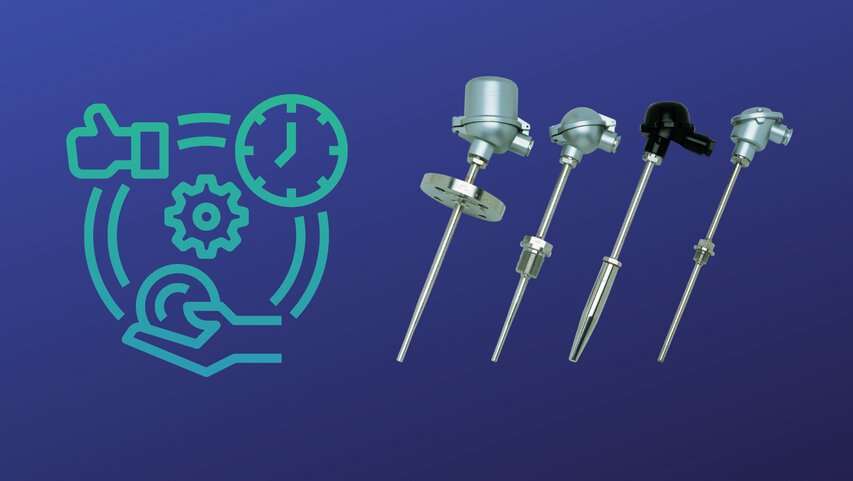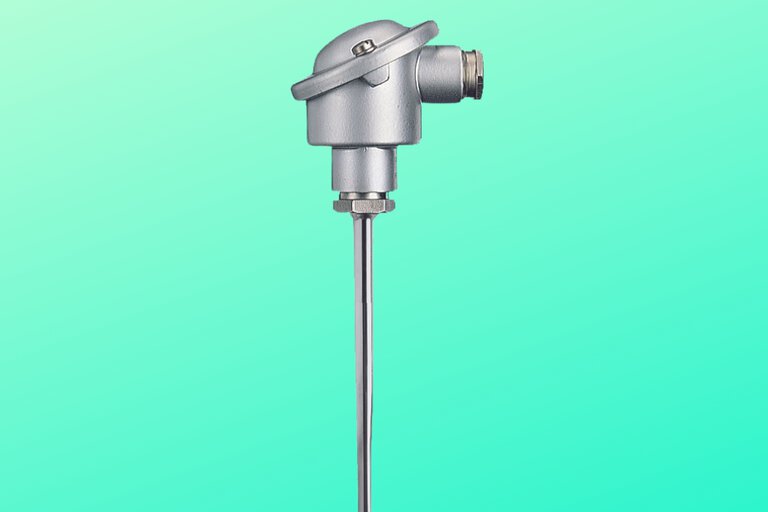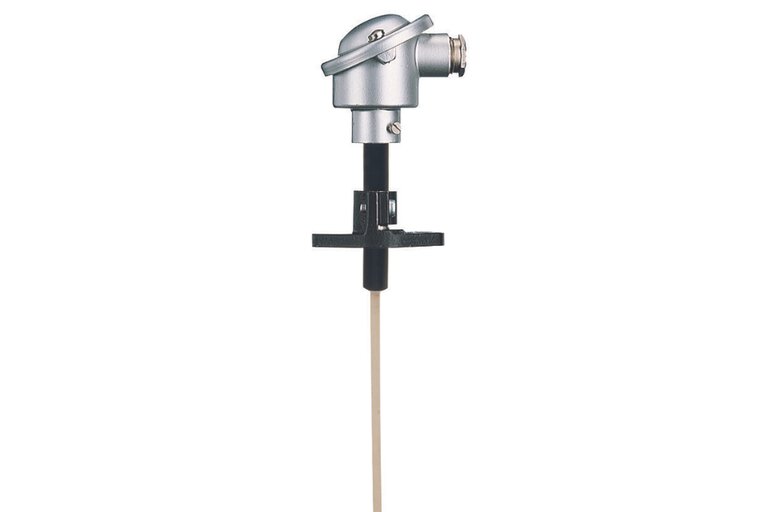

How to increase the efficiency of temperature measurements with a thermocouple? 7 important information
Thermocouples have now established themselves as standard temperature sensors, popular in a variety of industries due to their ability to operate over a wide measurement range and a reasonable level of accuracy. From this blog post, you'll learn how thermocouples work, the principles of their construction, and the correct thermocouple connection for accurate temperature measurements. We'll also discuss compensation cables, internal temperature compensation, and how to avoid short circuits in systems with thermocouples. Finally, we will look at the standardization of these thermocouple sensors and their long-term behavior. Read more!
1. Principle of operation and construction of thermocouple
How do thermocouples work? Thermocouples work by varying the thermoelectric properties of different metals, making it possible to measure temperature based on changes in voltage. These measuring devices consist of two metal wires, connected at one end, each with different thermoelectric properties. When the temperature of the junction increases, the charge carriers accelerate and move toward the cooler end. This movement generates a voltage that increases as the temperature and conductivity of the metals used increases. This thermoelectric phenomenon, known as the Seebeck effect, causes different conductivities in each metal, leading to different voltages on the two “legs.” The difference between these voltages (designated UT1) allows the temperature to be measured at the junction or directly at the measuring point.
At the other end, where the thermocouple connects to the measuring device, two partial voltages are created (UT2a and UT2b). Their sum, which would also occur if the thermocouple were short-circuited at a given temperature, reflects the temperature at the junction point, called the cold junction. This measured voltage allows you to determine the temperature difference - the difference between the hot measuring point and the colder cold junction.

Diagram of thermocouple operation showing the temperature measurement at the transition point (T1), the voltage difference between the cold junction (T2) and the field device that displays the measurement result.
2. Compensation wires and connectors free of thermoelectric voltage
Second voltage (UT2) at a cold junction:
In thermocouples, a voltage is created when two different metals are connected and exposed to different temperatures. One of these voltages, called UT2, is generated at the point where the thermocouple is connected to the wires (this point is called the cold junction).
Compensation wires:
Thermocouples are often used with compensation wires. These wires are made of materials that have similar thermoelectric properties to those in thermocouples. This allows them to be extended all the way to the measuring device without distorting temperature measurements.
Connectors free of thermoelectric voltage:
Connectors that do not generate additional thermoelectric voltage are very important. Why? If the connectors generated additional voltage, it could distort the accuracy of temperature measurements. Using such special connectors helps achieve more precise and reliable measurement results.

Thermocouple with compensation wire
3. Internal temperature compensation of the thermoelectric sensor
The field device calculates the temperature difference using the voltage difference between UT1 and UT2. How is the cold junction temperature (T2) measured? The cold junction temperature, designated T2, is measured with an additional temperature sensor, which is crucial for the accuracy of the measurement. Why is this important? This temperature (T2) is then added back to the calculated temperature difference (T1 - T2 + T2), giving us the final temperature value at the measuring point, labelled T1.
What is internal temperature compensation? It is a process that ensures that the temperature at the measuring point is determined accurately and reliably. A key element of this method is the reference temperature, which allows precise calculations and compensation for any differences.
4. Consideration of short circuits in systems with thermocouples
What happens when a short circuit occurs in the compensation wire? A short circuit in the compensation wire leads to the creation of an additional thermocouple operating in parallel with the original one. In other words, a new, unwanted thermocouple is created at the site of the short circuit. This causes the measured temperature to become the average of the temperature at the actual measurement site and the temperature at the short-circuit site.
For example, if the actual temperature at the measuring point is 200°C, and the temperature at the short-circuit point is 100°C, the device may show a temperature of about 150°C. This means that the measurement result is falsified and inappropriate to the actual conditions.
Unfortunately, the field device (that is, the device that processes the signal from the thermocouple) is not able to detect this type of short circuit. Why does this happen? These devices are designed to read voltage signals generated by thermocouples and do not have diagnostic functions that can indicate that an additional thermocouple has formed as a result of a short circuit.
As a result, temperature measurements in systems with thermocouples can be unreliable if there are short circuits in the compensation wires. Therefore, it is important to regularly check the condition of compensation wires and ensure that they are free of short circuits in order to obtain accurate and reliable temperature measurements.
5. Galvanic isolation in thermocouple measurement circuits
In thermocouple systems, short circuits, which are unwanted electrical connections, can occur between the thermocouple wires and the plant ground. What is plant ground? It is a reference point in electrical systems that is connected to the earth to ensure safety and proper functioning of equipment. Such a short circuit can happen in several scenarios. For example, a short circuit may occur between the connector junction and the protective tube. This type of connection is sometimes intentionally used to achieve a faster response to temperature changes. Another case is the reduction of the resistance of ceramic tubes, which can happen at high measurement temperatures. Reduced resistance means that electric current flows more easily through these tubes, increasing the risk of a short circuit.
To prevent such short circuits and the associated problems, galvanic isolation should be used. Galvanic isolation separates the thermocouple measurement circuit from the rest of the electrical system, preventing unwanted current flows that could interfere with measurements.
How can galvanic isolation be achieved? There are several methods:
- Transmitter: Using a transmitter that relays the measurement signal without a direct electrical connection.
- Power isolator: A device that supplies power to the measurement circuit while galvanically isolating it from the rest of the system.
- Analyzing unit: Some advanced measurement units have built-in galvanic isolation, eliminating the need for additional devices.
Using galvanic isolation is crucial for ensuring accurate and reliable temperature measurements, especially in harsh industrial environments where the risk of short circuits is high. With galvanic isolation, the measurement circuit is protected from unwanted interferences, allowing for precise results.
6. Standardization of thermocouples
Thermocouples are standardized according to the international standard DIN EN 60584-1, which ensures their compatibility in terms of electrical behavior. Depending on the materials used, a thermocouple can measure temperatures from -200°C to as much as 2500°C. The most common types of thermocouples are J, K and N, which do not contain precious metals. In contrast, S and B types are made of expensive precious metals and are designed for very high temperatures. Type B thermocouple allows the highest temperatures to be measured, with the standard setting the maximum value at 1,700 degrees Celsius. Once the appropriate type of thermocouple is selected, field devices automatically convert the measured value to the appropriate temperature scale.

Type B thermocouple for high temperature applications
7. Long-Term behavior of thermocouples
The recommended maximum operating temperatures for thermocouples, specified in standards, are intended for typical applications in clean air environments. This means that thermocouples operate most efficiently and accurately under controlled conditions where the air is free from contaminants and moisture. However, if thermocouples are used at higher temperatures than recommended, this can lead to increased signal drift. Signal drift refers to the gradual deviation of the indicated temperature from the actual value, which affects measurement accuracy.
Additionally, the output signal of thermocouples can change when foreign matter enters their structure. This can occur, for example, when thermocouples are used in industrial furnace atmospheres, where they may be exposed to various gases and contaminants, or in protective tubes that may eventually allow foreign substances to penetrate. These foreign materials can react with the metals of the thermocouple, altering its properties and causing inaccurate temperature readings.
Therefore, it is crucial to regularly calibrate thermocouples and properly adjust field devices that process thermocouple signals. Calibration involves checking and correcting the thermocouple's readings to ensure it continues to measure temperature accurately. The frequency of calibration and maintenance should be determined by the user based on the specific application and working conditions.
Ultimately, the user must decide how long the measuring instrument can be effectively used in a given installation. Regular monitoring, calibration, and maintenance of thermocouples are essential to ensure the accuracy and reliability of temperature measurements throughout the device's service life. This helps to avoid costly errors and maintain high-quality industrial processes.
Measurement precision with thermocouples - summary
In summary, thermocouples are key tools in temperature measurement, used in many industries because of their wide measurement range and good accuracy. They work on the principle of the Seebeck effect, generating a voltage in response to temperature differences between two different metals. Critical to the precision of the measurements is the proper connection of the thermocouple and the use of compensation wires to minimise interference. Internal cold junction temperature compensation is essential for accurate readings, and galvanic isolation helps avoid short-circuit problems. Standardisation to DIN EN 60584-1 ensures consistency of measurements, and regular calibration is necessary to maintain the accuracy and reliability of thermocouples over the long term.
About the author
My name is Ewelina Szmit and I have been working in the field of content marketing for several years, combining my professional skills with my passion for writing. I believe that even the most technical topics can be presented in an interesting and accessible way for everyone. Outside of work, I develop my creativity by creating newspaper collages. I like to spend my free time most actively, walking my dog or running.

Technical specialist
Katarzyna Tracz - Inside Sales Engineer +48 71 339 32 86 Katarzyna.Tracz@JUMO.net +48 71 339 32 86Comments
We encourage you to leave your comments via the form below. They will be posted online once they have been approved through our review process.


